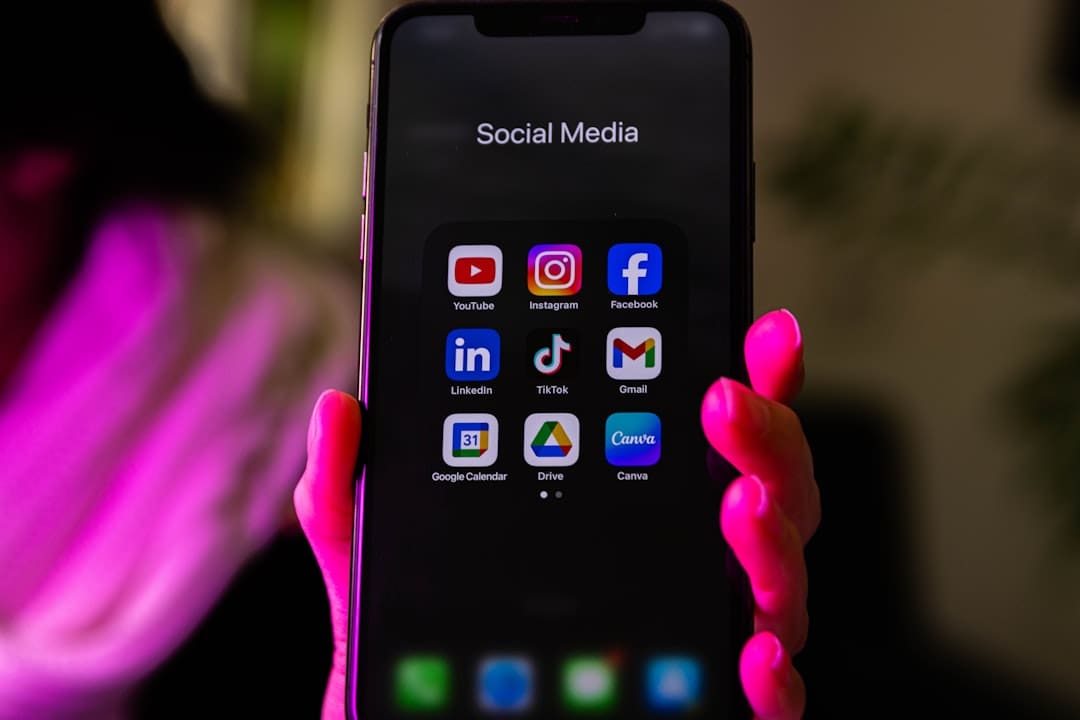Why Your Brand’s Digital Footprint Matters More Than Ever
Online reputation social media is the practice of monitoring, managing, and influencing how your brand appears across social platforms where customers share opinions, reviews, and experiences about your business.
Quick Answer for Online Reputation Social Media:
– What it is: Managing your brand’s perception across Facebook, Twitter, Instagram, LinkedIn, and review sites
– Why it matters: 94.2% of internet users are on social media monthly, and 63% say social customer service affects their brand loyalty
– Key actions: Monitor mentions, respond quickly (within 24 hours), encourage positive reviews, and address complaints professionally
– Main goal: Build trust and credibility while preventing negative content from damaging your business
With 75% of B2B buyers using social media to make purchasing decisions and 92.4% of consumers relying on online reviews, what people say about your brand online directly impacts your bottom line. A single negative post can spread like wildfire, but positive engagement builds lasting customer relationships and drives real business growth.
The challenge isn’t just managing what you post. It’s about monitoring conversations, responding to feedback quickly, and turning every interaction into an opportunity to strengthen your brand. Companies that master this see improved customer loyalty, higher conversion rates, and protection against reputation crises.
I’m Magee Clegg, founder and CEO of Cleartail Marketing, where we’ve helped 90+ B2B companies build stronger online reputation social media strategies that drive measurable results. Over the past decade, I’ve seen how the right reputation management approach can transform struggling brands into industry leaders.
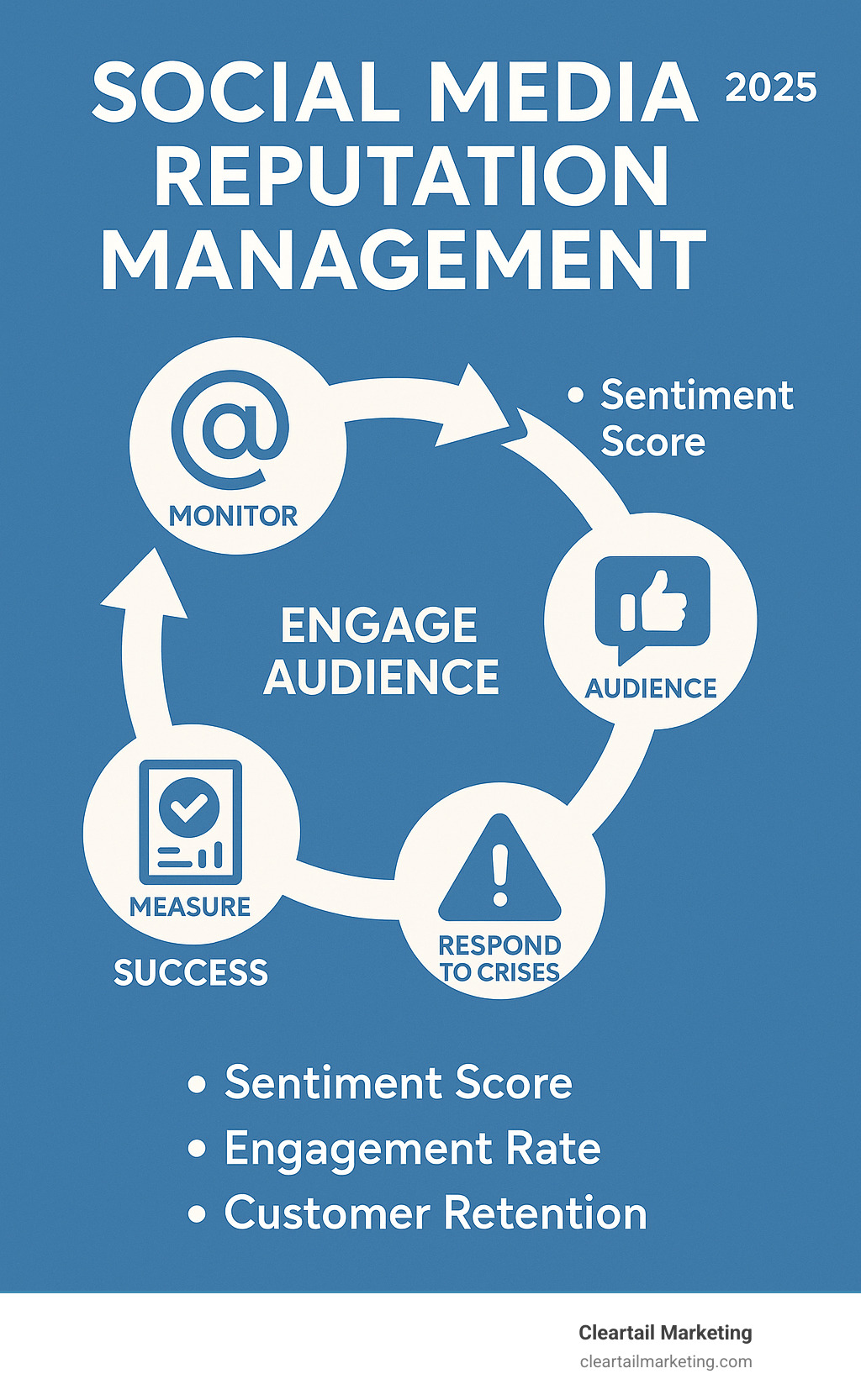
Online reputation social media vocab to learn:
– google online reputation
– positive online presence
– positive reputation management
Understanding Online Reputation Social Media
Online reputation social media is how people perceive, talk about, and evaluate your brand across every social platform. It’s not just about the posts you share – it’s about every comment, review, mention, and shared experience that creates a collective impression of your business.
The digital word-of-mouth effect is incredibly powerful. With 94.2% of internet users active on social media monthly, millions of conversations about brands happen every day. What makes this different from traditional word-of-mouth is the scale and permanence.
The numbers tell a compelling story:
– 76% of consumers regularly read online reviews when browsing for local businesses
– 92.4% of consumers use online reviews to guide purchasing decisions
– 75% of B2B buyers use social media to make buying decisions
– 76% of all reviews are spread between Google and Facebook
At the heart of social media reputation management is sentiment analysis – understanding the emotional tone behind what people say about your brand. This emotional context often matters more than the actual words used.
Conversations happen whether you’re participating or not. 63% of consumers say that social media customer service quality significantly influences their brand loyalty, which means every interaction becomes an opportunity to strengthen or weaken relationships.
Why Online Reputation Social Media Matters
Brand loyalty grows stronger when customers see you actively engaging online. 65% of consumers feel more connected to brands with a robust social media presence. When people see you responding to questions and celebrating customer wins, they develop genuine emotional connections that translate into repeat business.
Purchase decisions happen faster when potential customers can easily find positive social proof. With 90% of consumers using social media to keep up with trends, your social presence influences buying behavior throughout the entire customer journey.
SEO benefits compound over time as your social activity creates valuable signals that search engines notice. Strong social media presence can also help push negative search results further down where fewer people will see them.
Crisis prevention works better than crisis management. Active social media monitoring acts as an early warning system, helping you spot potential issues before they explode into reputation disasters.
Key Components of Online Reputation Social Media
Social listening tracks mentions of your brand name, key employees, competitors, and industry keywords across all platforms. People often share opinions about your business without tagging you directly.
Engagement strategy determines how customers feel after interacting with you. 76% of consumers value how quickly a brand responds to their needs, and nearly 70% expect a response within 24 hours or less.
Content quality builds credibility through consistent, valuable posts that demonstrate your expertise. High-quality content positions you as a trusted resource.
Review management requires both encouraging positive feedback and professionally addressing negative experiences across social platforms and third-party sites.
Crisis planning prepares you for when things go wrong. Having predetermined response templates and escalation procedures can mean the difference between containing a problem and watching it spiral out of control.
Building a Proactive Reputation Management Framework
Online reputation social media management is like tending a garden – you can’t just water it when it’s dying and expect beautiful flowers. The most successful brands have systematic approaches that catch opportunities and threats before they become major issues.
After helping 90+ companies build their reputation management systems, I’ve seen how businesses with proactive frameworks spot problems 5x faster than those who only react when crisis hits.
Your foundation starts with choosing the right monitoring tools. Google Alerts will catch the basics for free, but if you’re serious about protecting your brand, you’ll want something more robust. Hootsuite and Sprout Social offer solid monitoring with sentiment tracking, while enterprise-level tools like Brandwatch and Talkwalker provide AI-powered insights.
| Tool Type | Free Options | Paid Options |
|---|---|---|
| Basic Monitoring | Google Alerts, Social Mention | Hootsuite Insights, Sprout Social |
| Advanced Analytics | Native platform insights | Brandwatch, Talkwalker |
| Sentiment Analysis | Limited manual review | AI-powered sentiment scoring |
| Competitor Tracking | Manual searches | Automated benchmarking |
Beyond tools, you need clear policies and response templates. Companies with predetermined response guidelines handle negative situations 67% more effectively than those winging it. Create templates for celebrating positive reviews, addressing complaints professionally, handling neutral inquiries, and managing crisis situations.
Employee advocacy matters too. When 70% of consumers feel stronger connections to brands with active CEOs on social media, having your team act as positive ambassadors multiplies your reputation efforts.
If you’re looking to expand beyond reputation management, our Social Media Management services integrate reputation monitoring with comprehensive social strategy.
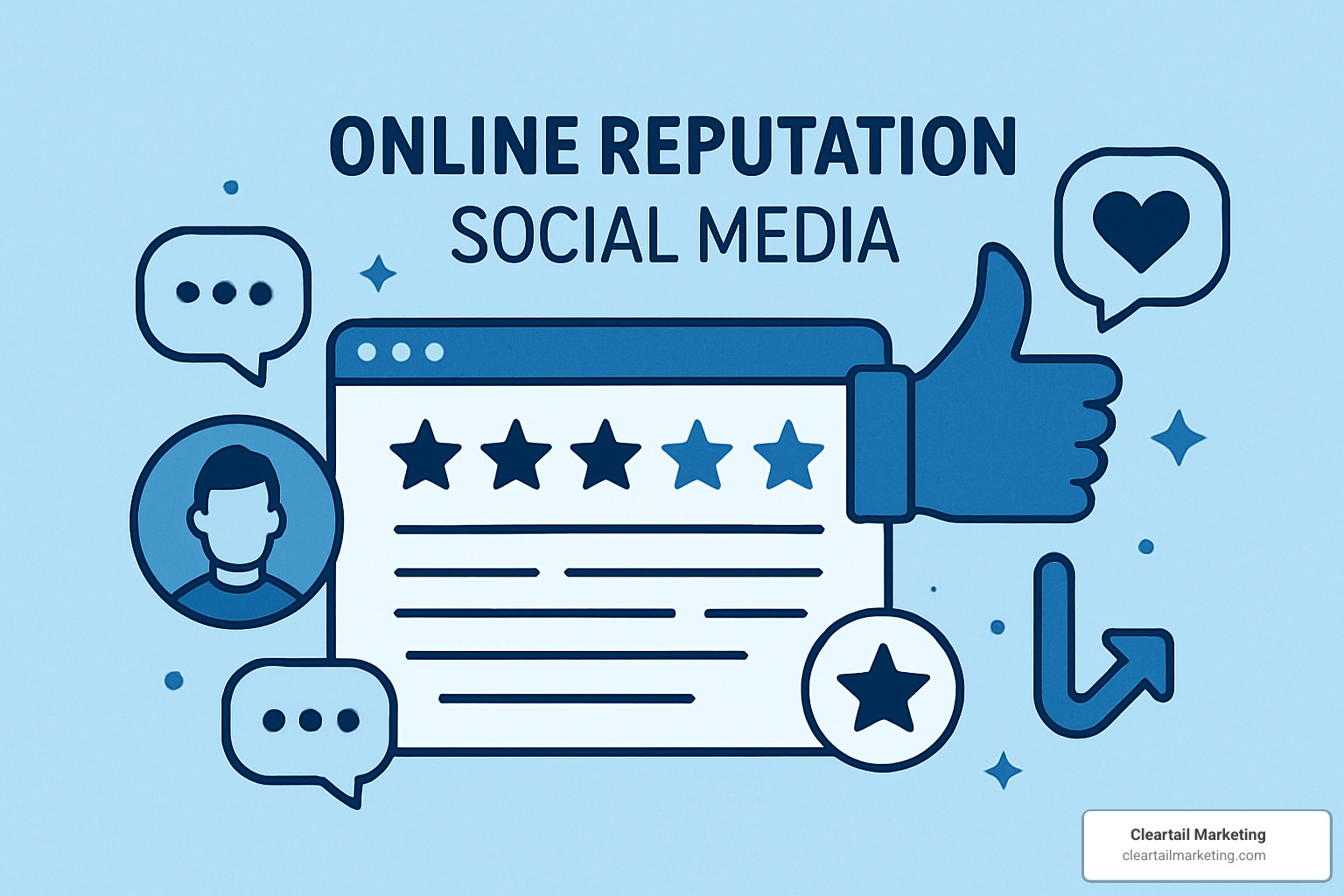
Step 1: Audit & Monitor Constantly
Before diving into online reputation social media improvements, you need a crystal-clear picture of where you stand today.
Start with the detective work. Search for your brand name across Facebook, Twitter, Instagram, LinkedIn, TikTok, and YouTube – but don’t stop at your official profiles. Look for untagged mentions, common misspellings of your company name, and conversations about your industry.
Many monitoring platforms now offer “Reputation Score” metrics that combine mention reach and sentiment into a single number from -100 to 100. This gives you a baseline to track improvement over time. We’ve seen companies improve their scores by 40+ points within six months using consistent monitoring and response strategies.
Set up alerts for your exact brand name and common misspellings, all product or service names, key executives’ names, industry hashtags, and competitor mentions for benchmarking. Daily monitoring works best for active brands, with weekly deep-dive reviews to spot trends.
Step 2: Engage & Amplify Positives
Once your monitoring system is running, shift focus to amplifying the good stuff. This proactive approach builds positive momentum that cushions your brand when challenges arise.
Make it easy for happy customers to share their experiences. When 55% of consumers say that brands liking or responding to their comments helps them feel more connected, these small interactions create lasting loyalty.
Spotify Cares masters this approach. They actively monitor untagged mentions and jump into conversations where users express frustration, even when not directly contacted. This proactive customer service has built them a reputation for caring.
The key is being genuinely helpful, not promotional. Share customer testimonials as social posts, respond to positive comments with real appreciation, and ask satisfied customers to leave reviews on Google and Facebook. Feature customer success stories in your regular content mix.
Step 3: Content Strategy That Builds Trust
Your content strategy forms the bedrock of your online reputation social media presence. Focus on providing genuine value rather than constant promotion. Share industry insights, practical how-to guides, behind-the-scenes glimpses, and educational resources that help your audience succeed.
CEO visibility makes a massive difference in building trust. When leaders share authentic insights and engage personally, it humanizes your entire brand. Regular, genuine participation from leadership creates stronger emotional connections with your audience.
Consistency across platforms builds instant recognition. Use the same profile photos, brand colors, and core messaging everywhere. Maintain a regular posting schedule – it’s better to post less frequently but consistently than to post sporadically.
Multimedia content consistently outperforms text-only posts. Videos, infographics, and interactive content generate higher engagement rates and more shares. Live video streams particularly boost trust because they showcase authenticity in real-time.
Handling Negative Feedback & Crisis Response
Negative feedback is going to happen, no matter how amazing your business is. How you handle these situations often matters way more than the original complaint itself.
Here’s a sobering reality: it takes about 12 positive interactions to recover from one negative feedback. That’s why getting your response right the first time is absolutely critical for your online reputation social media strategy.
Speed is everything when it comes to damage control. 76% of consumers value how quickly a brand responds to their needs, and nearly 70% expect a response within 24 hours or less. Wait longer than that, and you’re dealing with both the original issue and the perception that you don’t care.
When that negative comment pops up, here’s your game plan: acknowledge quickly and publicly to show you’re paying attention, express genuine empathy without necessarily admitting fault, move the conversation to private channels like direct messages, and then follow up publicly once you’ve resolved the issue.
One unhappy customer can reach hundreds or thousands of potential customers within hours. But when you handle complaints professionally and with genuine care, you often turn your biggest critics into your strongest advocates.
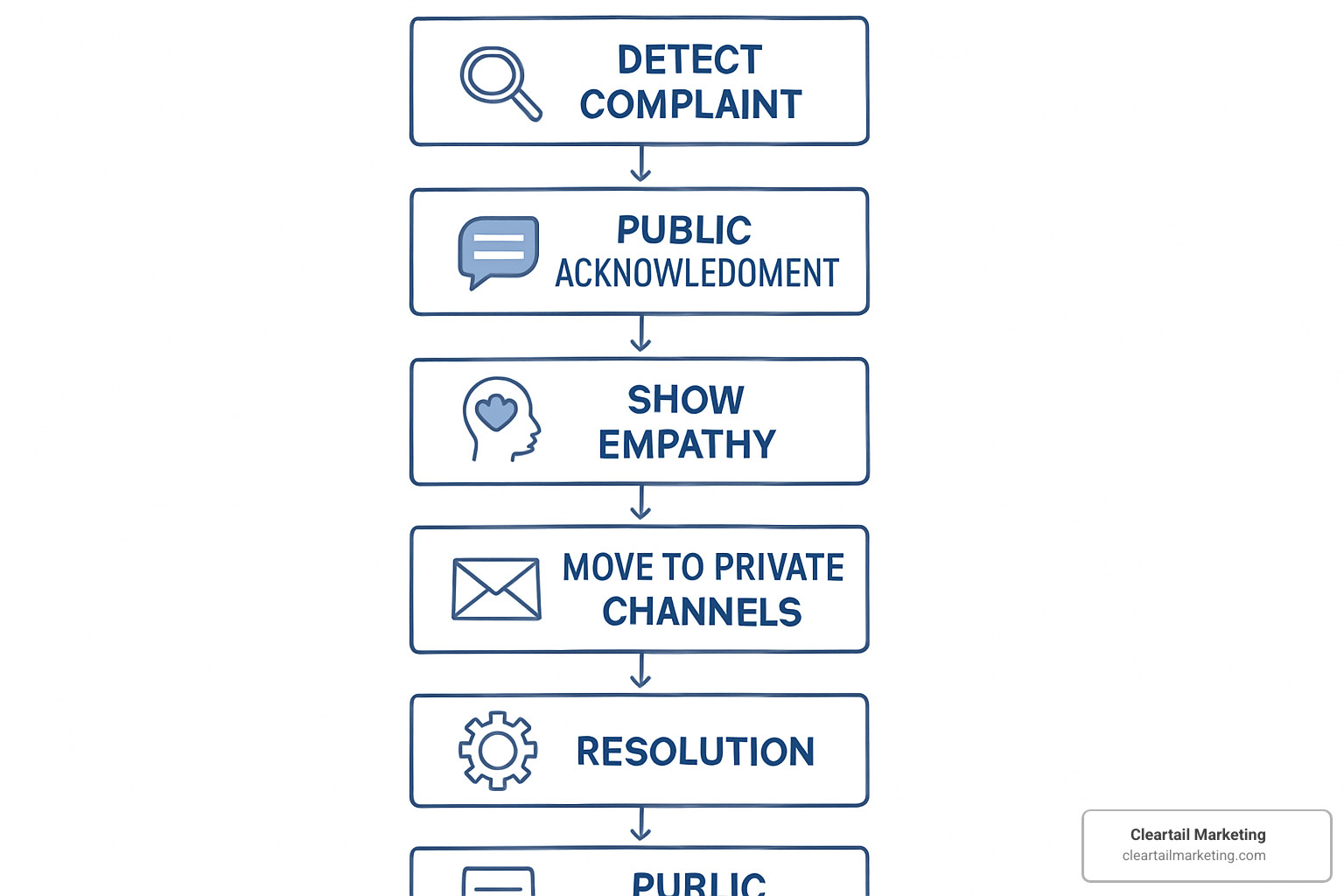
Turning Complaints into Opportunities
Negative feedback can actually strengthen your online reputation social media presence when you handle it right. When potential customers see you professionally resolving complaints in public, it shows them exactly how you’ll treat them if something goes wrong.
The secret sauce is personalization. Those generic “We’re sorry you had a bad experience” responses make things worse. Instead, address the specific problem, use the customer’s name, and offer real solutions.
Start with an immediate acknowledgment: “Hi Sarah, we’re really sorry to hear about your delivery experience. This definitely isn’t the level of service we aim for.” Then make a concrete solution offer: “Could you send us a DM with your order number? We want to make this right today.” Finally, provide a public follow-up: “Update: We’ve resolved Sarah’s delivery issue and worked with our shipping partner to prevent this from happening again.”
This approach shows the original customer that you care, and it shows everyone else watching that you stand behind your service. Sometimes the best marketing isn’t perfect reviews, it’s perfect responses to imperfect situations.
Crisis Playbook for Online Reputation Social Media
When individual complaints turn into something bigger, you need a crisis playbook ready to go. The key is recognizing when you’re dealing with a crisis versus just a regular complaint. Watch for sudden spikes in negative mentions.
Your crisis response needs an escalation matrix that clearly defines when issues need executive involvement, legal review, or outside help. Not every angry tweet needs the CEO’s attention, but when something could seriously damage your brand, you need all hands on deck.
Cross-channel consistency becomes crucial during a crisis. If you’re addressing an issue on Twitter, make sure your Facebook, LinkedIn, and website all tell the same story. Mixed messages during a crisis can make you look disorganized or dishonest.
For serious situations, have a legal review process in place. Sometimes the smartest move is to take a step back and gather all the facts before responding publicly.
Measuring & Optimizing Your Social Reputation
If you’re not measuring your online reputation social media management, you’re just guessing. Once you start measuring the right things, improvement becomes much easier. You’ll spot problems before they become crises, identify what content resonates most, and prove the real business impact of your reputation efforts.
Sentiment Score is your north star metric – it shows the ratio of positive to negative mentions over time. Focus on monthly trends rather than daily fluctuations. A steady upward trend indicates your reputation is strengthening, while sudden drops signal issues that need immediate attention.
Engagement Rate reveals how connected your audience feels to your brand. When people actively like, comment, share, and respond to your content, it shows genuine interest. Higher engagement rates also boost your content’s visibility on most platforms.
Share of Voice compares your brand’s mention volume to competitors. This metric shows whether you’re leading industry conversations or falling behind.
Response Time directly correlates with customer satisfaction. 76% of consumers value how quickly a brand responds to their needs. Track your average response time and work to improve it consistently.
Review Rating Changes across platforms like Google, Facebook, and industry-specific sites show how customer perception evolves. A gradual increase in average ratings indicates improving customer experience.
Reach and Impressions measure how many people see content about your brand – both from your posts and others’ mentions. This helps you understand your true visibility and influence.
For comprehensive analysis, specialized social media analytics tools provide deeper insights than basic platform analytics. These tools can track sentiment across multiple platforms, identify trending topics, and benchmark your performance against competitors.
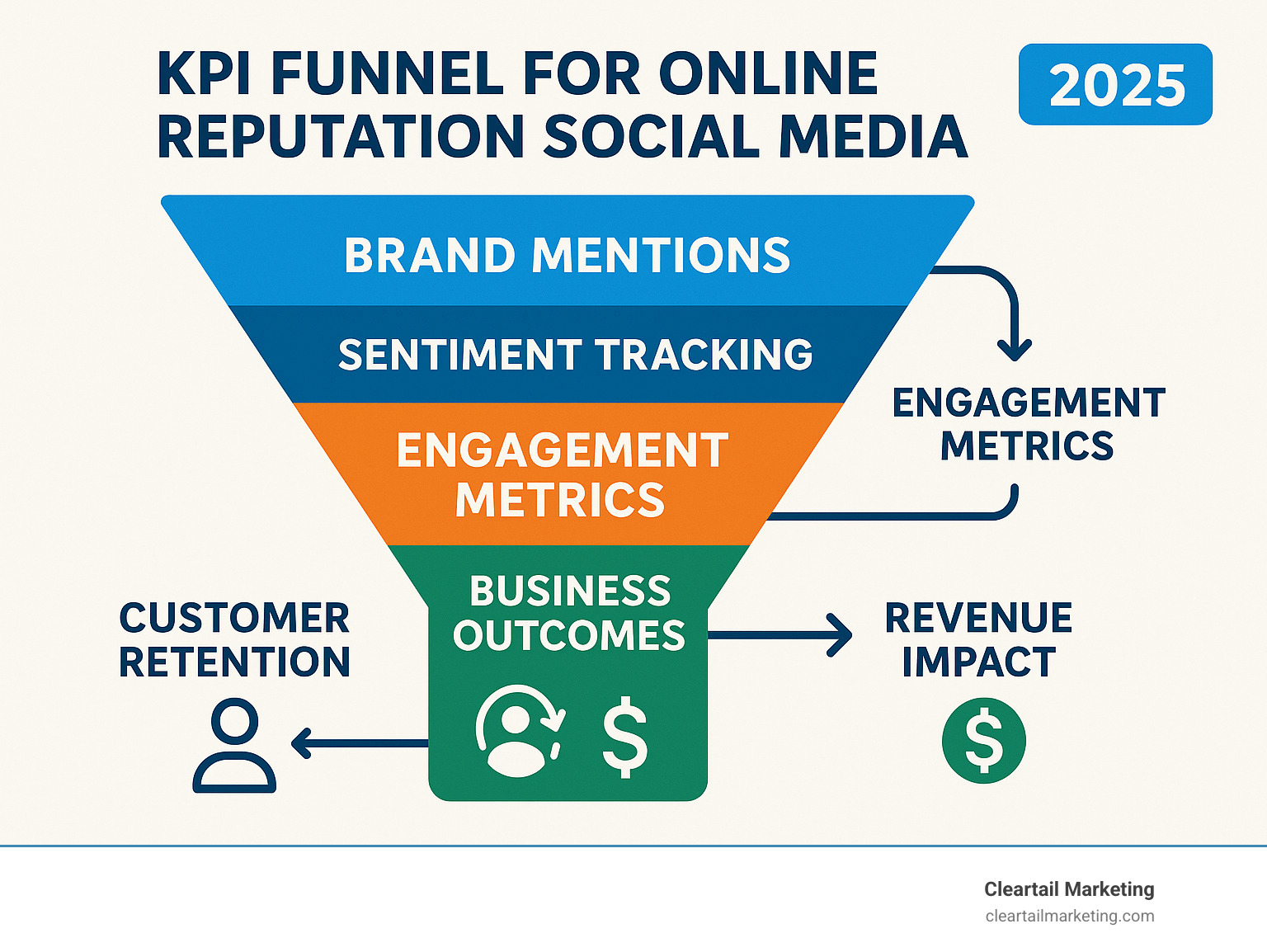
Tools & Dashboards to Track Progress
The measurement landscape ranges from free native platform insights to sophisticated third-party analytics suites. Native tools like Facebook Insights, Twitter Analytics, and LinkedIn Analytics provide solid baseline data about your own content performance.
Third-party tools offer game-changing capabilities. AI-powered sentiment analysis can process thousands of mentions daily and identify emotional trends that would take hours to analyze manually. These systems learn to recognize sarcasm, context, and nuanced opinions that simple keyword matching misses.
Automated reporting transforms how you stay on top of your reputation. Set up weekly or monthly reports that track your key metrics and highlight significant changes. This creates accountability within your team and helps you spot emerging trends before they become problems.
The sweet spot is balancing automation with human insight. AI excels at processing volume and identifying patterns, but human judgment remains essential for nuanced responses and strategic decisions.
For businesses ready to lift their reputation management with professional-grade monitoring and strategic optimization, our Brand Online Reputation Management services provide comprehensive tracking, analysis, and response management that turns reputation monitoring into a competitive advantage.
The key is consistency. Choose your metrics, set up your tracking systems, and review performance regularly. What gets measured gets improved – and in online reputation social media, improvement directly impacts your bottom line.
Future Trends & Getting Started for Small Businesses
The world of online reputation social media is changing rapidly. AI chatbots are already revolutionizing customer service, handling up to 80% of routine interactions while keeping your brand available 24/7. This frees up your team to focus on complex issues that need a human touch.
Predictive sentiment analysis can spot trouble brewing in your online conversations days or weeks before it becomes a real problem. Imagine getting an alert that says “customers are starting to complain about shipping delays” before it turns into a social media crisis.
TikTok is becoming the new Google for younger customers. Gen Z users are searching for businesses, reading reviews, and making purchase decisions right on the platform. If your reputation management strategy doesn’t include TikTok, you’re missing a huge piece of the puzzle.
Video content isn’t just trending anymore – it’s dominating. Short videos, live streams, and interactive content get way more engagement than traditional posts. The brands winning at reputation management are telling their stories through video, showing real people and authentic moments.
Don’t overlook micro-communities either. Those niche Facebook groups, industry forums, and specialized platforms where your ideal customers hang out often influence buying decisions more than your main social media presence.
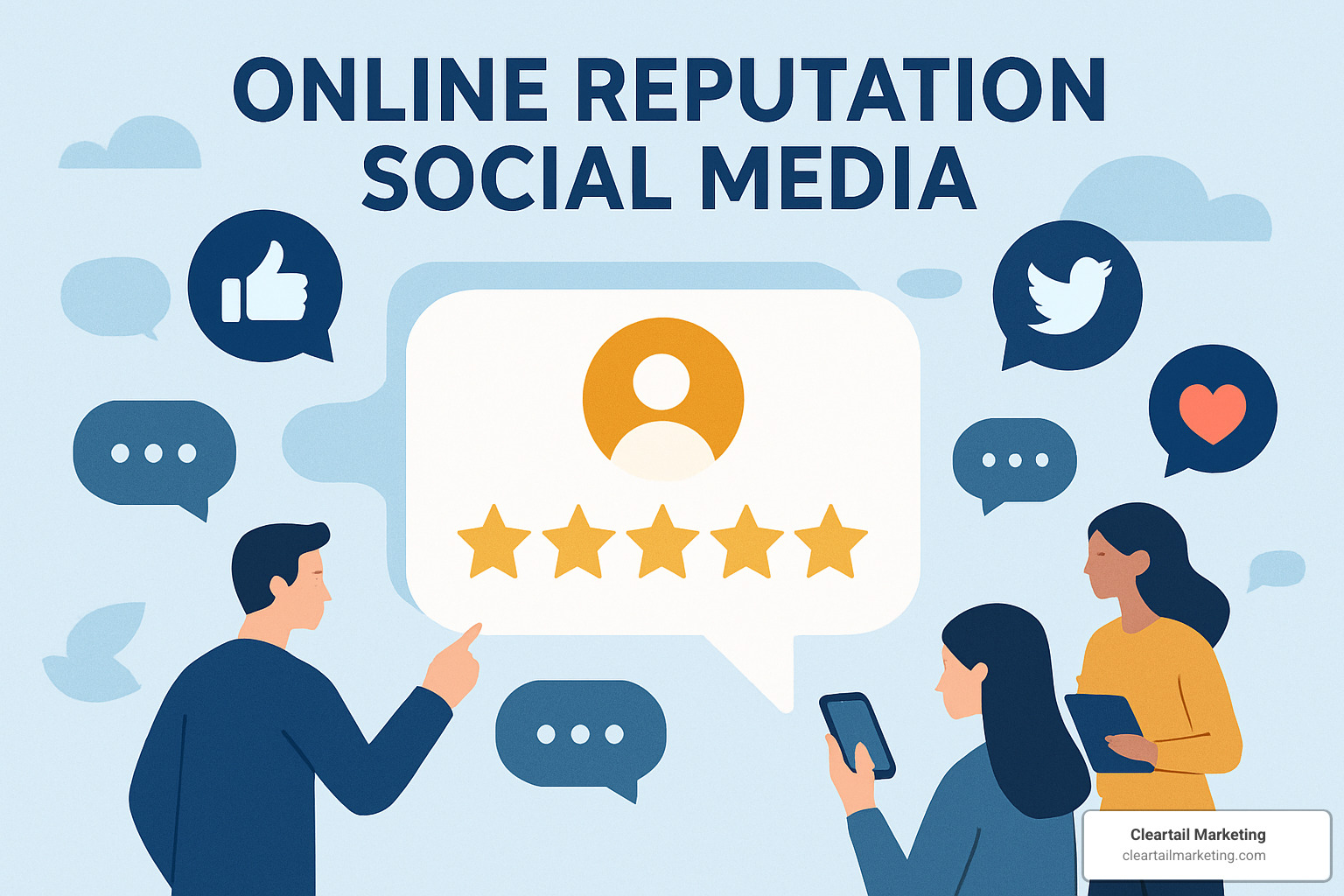
Quick-Start Checklist for Small Teams
Starting your online reputation social media journey doesn’t have to be overwhelming. The key is taking it step by step and building good habits from day one.
First, claim your digital territory. Register your business name on all major social platforms, even if you’re not ready to use them yet. Set up your Google Business Profile too – it’s free and shows up in local searches constantly.
Get your monitoring basics in place. Google Alerts costs nothing and catches most mentions of your business name. Create accounts on the platforms where your customers actually spend time. Install a few free monitoring tools to track what people are saying about you.
Prepare your response game. Write out professional responses for common situations before you need them. Train anyone on your team who might respond to customers online. Know when to escalate issues to management.
Make reviews part of your routine. Build asking for reviews into your normal customer service process. Happy customers usually don’t mind helping if you make it easy and ask politely. Always respond to reviews – yes, even the good ones.
Stay consistent with your presence. Post regularly, even if it’s just once or twice a week. Use the same logo, colors, and voice across all platforms so customers recognize you instantly.
Online Reputation Social Media & AI: What’s Next?
Artificial intelligence is making reputation management smarter and more efficient every day. Real-time alerts now catch reputation issues the moment they start spreading. AI can analyze the emotional tone of hundreds of comments and tell you exactly how people feel about your brand.
Automated moderation helps filter out spam and inappropriate content while flagging real customer concerns for human review. This means you can handle more conversations without sacrificing quality.
The most exciting development is personalized content recommendations. AI studies what your audience engages with and suggests content that’s more likely to build positive relationships.
But technology is just a tool. The future of online reputation social media will always need human judgment for strategic decisions and genuine communication. AI can process the data and spot the patterns, but building real relationships with customers requires that human touch that no algorithm can replace.
The brands that will thrive are the ones that use AI to work smarter while keeping their communication authentic and personal.
Conclusion & Next Steps
Your online reputation social media journey doesn’t end when you implement these strategies – it’s actually just the beginning. Think of reputation management like tending a garden. You plant the seeds with great content and customer service, water them with consistent engagement, and protect them from negative feedback that tries to take root.
The businesses we work with at Cleartail Marketing often tell us they wish they’d started managing their online reputation sooner. We’ve guided over 90 B2B companies through this change, and the pattern is always the same. Companies that treat reputation management as a strategic advantage rather than a defensive chore see remarkable results within months.
Here’s what typically happens when businesses get serious about their social media reputation. First, they notice faster response times leading to happier customers. Then, positive reviews start outweighing negative ones. Finally, they see the big picture benefits: higher conversion rates, increased customer loyalty, and protection against reputation crises.
The key insight we’ve learned? Your reputation builds one conversation at a time. Every comment you respond to, every helpful post you share, and every customer concern you address adds another brick to your reputation foundation. It’s not about perfection – it’s about consistency and genuine care for your customers.
Starting feels overwhelming, but you don’t need to master everything at once. Begin with monitoring your brand mentions daily, responding to comments within 24 hours, and asking satisfied customers for reviews. These simple actions create momentum that builds over time.
As you grow more confident, expand into advanced strategies like predictive analytics and AI-powered sentiment analysis. But remember, technology should improve human connection, not replace it. Your customers want to feel heard and valued, not like they’re talking to a robot.
The continuous improvement mindset makes all the difference. Track your progress monthly, celebrate wins (even small ones), and learn from challenges. Your reputation management skills will sharpen with practice, just like any other business capability.
Ready to transform your online reputation from a source of worry into a competitive advantage? Our Reputation Management Services take the guesswork out of the process. We handle the monitoring, help craft your responses, and provide strategic guidance custom to your industry and goals.
Your future customers are forming opinions about your business right now based on what they find online. The question isn’t whether they’ll judge your brand – it’s whether they’ll find the story you want to tell or the story that’s been told for you.
Start protecting and building your brand today. Your reputation is too important to leave to chance.


